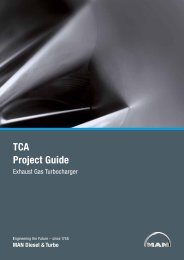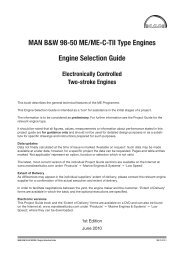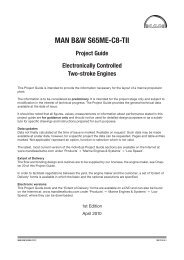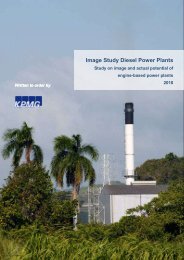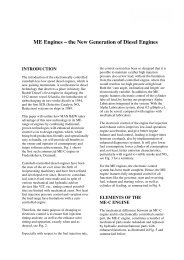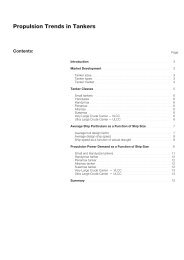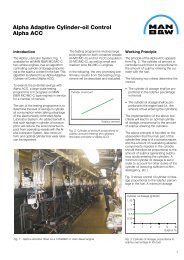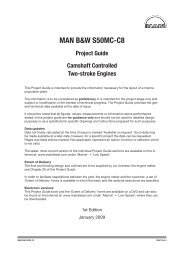This section is available on request - MAN Diesel & Turbo
This section is available on request - MAN Diesel & Turbo
This section is available on request - MAN Diesel & Turbo
Create successful ePaper yourself
Turn your PDF publications into a flip-book with our unique Google optimized e-Paper software.
<strong>MAN</strong> B&W 15.04<br />
Comp<strong>on</strong>ents of the Exhaust Gas System<br />
������������������<br />
�����������������<br />
�������������<br />
�������������<br />
�����������������������<br />
<strong>MAN</strong> B&W MC/MC�C, ME/ME�C/ME�GI/ME-B engines<br />
178 42 78�3.2<br />
Fig. 15.04.01a: Exhaust gas system, <strong>on</strong>e turbocharger<br />
Exhaust gas compensator after turbocharger<br />
When dimensi<strong>on</strong>ing the compensator (opti<strong>on</strong>:<br />
4 60 6 0) for the expansi<strong>on</strong> joint <strong>on</strong> the turbocharger<br />
gas outlet transiti<strong>on</strong> piece (opti<strong>on</strong>: 4 60 60 )<br />
the exhaust gas piece and comp<strong>on</strong>ents, are to be<br />
so arranged that the thermal expansi<strong>on</strong>s are absorbed<br />
by expansi<strong>on</strong> joints. The heat expansi<strong>on</strong> of<br />
the pipes and the comp<strong>on</strong>ents <str<strong>on</strong>g>is</str<strong>on</strong>g> to be calculated<br />
based <strong>on</strong> a temperature increase from 20 °C to<br />
250 °C. The max. expected vertical, transversal<br />
and l<strong>on</strong>gitudinal heat expansi<strong>on</strong> of the engine<br />
measured at the top of the exhaust gas transiti<strong>on</strong><br />
piece of the turbocharger outlet are indicated in<br />
Fig. 5.06.0 and Table 5.06.02 as DA, DB and DC.<br />
The movements stated are related to the engine<br />
seating, for DC, however, to the engine centre. The<br />
figures indicate the axial and the lateral movements<br />
related to the orientati<strong>on</strong> of the expansi<strong>on</strong> joints.<br />
The expansi<strong>on</strong> joints are to be chosen with an elasticity<br />
that limits the forces and the moments of the<br />
exhaust gas outlet flange of the turbocharger as<br />
stated for each of the turbocharger makers in Table<br />
5.06.04. The orientati<strong>on</strong> of the maximum perm<str<strong>on</strong>g>is</str<strong>on</strong>g>sible<br />
forces and moments <strong>on</strong> the gas outlet flange<br />
of the turbocharger <str<strong>on</strong>g>is</str<strong>on</strong>g> shown in Fig. 5.06.03.<br />
��<br />
������������<br />
��������<br />
��<br />
������������<br />
������<br />
��<br />
����������������<br />
�����������������������<br />
<strong>MAN</strong> <strong>Diesel</strong><br />
������������������<br />
�����������������<br />
����������������<br />
�������������<br />
�������������<br />
����������������<br />
�������������<br />
�����������������������<br />
Exhaust gas boiler<br />
������������<br />
��������<br />
������������<br />
������<br />
Page of 2<br />
Engine plants are usually designed for util<str<strong>on</strong>g>is</str<strong>on</strong>g>ati<strong>on</strong> of<br />
the heat energy of the exhaust gas for steam producti<strong>on</strong><br />
or for heating the thermal oil system. The<br />
exhaust gas passes an exhaust gas boiler which <str<strong>on</strong>g>is</str<strong>on</strong>g><br />
usually placed near the engine top or in the funnel.<br />
It should be noted that the exhaust gas temperature<br />
and flow rate are influenced by the ambient<br />
c<strong>on</strong>diti<strong>on</strong>s, for which reas<strong>on</strong> th<str<strong>on</strong>g>is</str<strong>on</strong>g> should be c<strong>on</strong>sidered<br />
when the exhaust gas boiler <str<strong>on</strong>g>is</str<strong>on</strong>g> planned. At<br />
specified MCR, the maximum recommended pressure<br />
loss across the exhaust gas boiler <str<strong>on</strong>g>is</str<strong>on</strong>g> normally<br />
50 mm WC.<br />
<str<strong>on</strong>g>Th<str<strong>on</strong>g>is</str<strong>on</strong>g></str<strong>on</strong>g> pressure loss depends <strong>on</strong> the pressure losses<br />
in the rest of the system as menti<strong>on</strong>ed above.<br />
Therefore, if an exhaust gas silencer/spark arrester<br />
<str<strong>on</strong>g>is</str<strong>on</strong>g> not installed, the acceptable pressure loss<br />
across the boiler may be somewhat higher than the<br />
max. of 50 mm WC, whereas, if an exhaust gas<br />
silencer/spark arrester <str<strong>on</strong>g>is</str<strong>on</strong>g> installed, it may be necessary<br />
to reduce the maximum pressure loss.<br />
The above menti<strong>on</strong>ed pressure loss across the<br />
exhaust gas boiler must include the pressure<br />
losses from the inlet and outlet transiti<strong>on</strong> pieces.<br />
��<br />
��<br />
��<br />
��<br />
������������������������������<br />
���������������<br />
Fig. 15.04.01b: Exhaust gas system, two or more TCs<br />
��<br />
178 33 46�7.4<br />
198 40 75�8.6



